 At the tail end of the twentieth century, from 1990 till its demise in 1995, I contributed regularly to the magazine Camera & Darkroom, a newsstand monthly ― aimed at advanced amateur and professional photographers ― whose editors proved surprisingly open to my critical writings.
At the tail end of the twentieth century, from 1990 till its demise in 1995, I contributed regularly to the magazine Camera & Darkroom, a newsstand monthly ― aimed at advanced amateur and professional photographers ― whose editors proved surprisingly open to my critical writings.
Browsing through my collection of back issues this past weekend, I happened across one that appeared 20 years ago this month. It included an essay, “Avoiding Photonic Impaction” by Homer LaFluts, on the problem with lenses created by the accumulation over time of stray photons, and the solutions thereto. (Click here for a PDF.) Somehow I’d passed it by when the issue first came out.
•
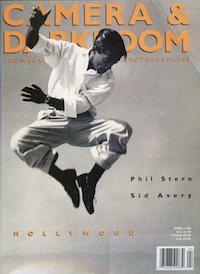
Camera & Darkroom, April 1994, cover
Reading LaFluts’s excellent diagnostic and advisory text for the first time brought back to me a long-buried memory, and may have explained its significance as well.
My first encounter with photography came as a result of my late mother’s interest. An avid amateur at the time of my birth in 1943, Mom introduced me to the medium when I was ten years old, buying me a used box camera. (By then she wasn’t doing much work of her own, though in the late 1960s she took it up again, developing something of a second career as a wildlife photographer under the name Fran Allan. Her work is represented by the stock agency Animals Animals.)
Part of Mom’s instruction to me on the care and cleaning of lenses always involved a ritual she referred to as “getting the stray ones out.” Tucked away in her camera bag, she kept one of those little rubber-headed mallets that doctors use to test your knee reflexes. Whenever we gave the equipment a thorough going-over, she would have me hold each of her lenses up and turn it slowly, while she tapped ― with the pointed end of the mallet’s head ― very lightly but rapidly around the barrel. Then together, we would blow as hard as we could across the ends of the lens. I still remember the way she smiled at me with her eyes as we did so; it made for one of those unforgettable moments of bonding between mother and son.
Mom never explained why we did this, nor what we supposedly cleaned out by our actions. Truth be told, I’m not sure she knew; she’d never studied photography formally, but learned it instead during two years’ apprenticeship, circa 1940, with the New York photographer and filmmaker Arnold Eagle, a member of the Photo League. All she would ever say, when I pressed her on this once, was, “That’s how Arnold did it ― every three months, just like clockwork.”
In any case, I know for a fact that Mom continued this practice until she put her cameras away permanently in 1977. (For a more scientific explanation, see “One Photon In, TWO Photons Out,” from the Joint Quantum Institute, a research partnership between the University of Maryland and the National Institute of Standards and Technology, with the support and participation of the Laboratory for Physical Sciences. For more on questions re photonics, see the journal Nature Photonics.)
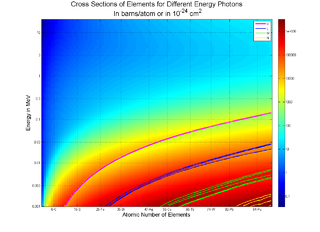
Cross-sections for photons in energy range from 1 keV to 20 MeV for Elements Z = 1 to 100. Courtesy Wikimedia Commons.
What else could this have represented but a simplified, down-and-dirty method for reversing impaction? I never had a chance to discuss this with Eagle, nor with any other former Photo League members, so I’ve no idea whether this was standard practice among them, or common in professional photography circles at the time.
(Perhaps some of those who’ve done oral historianship on that period ― the scholar Naomi Rosenblum, wife of former Photo Leaguer Walter Rosenblum, and Houston-based curator Anne Tucker, who’s made the definitive study of the Photo League, both come immediately to mind ― might review their notes and see what pops up on this subject.)
Nor am I in a position to certify this technique’s effectiveness, though Eagle’s own work in both media to this day shows no evidence of impaction-related problems. While LaFluts didn’t go into it, this issue affects cinematography as well, needless to say, though with some curious differences; obviously, there’s fertile ground here for further research. I’ve seen nothing on this in relation to digital cameras and lenses, I might add. Perhaps they’ve found electronic ways to counteract or even prevent impaction; possibly something inherent in the digital-imaging process blocks the impaction effect.
•
Not so incidentally, the impaction problem afflicts lens instruments other than cameras. Some of this blog’s readers are aware that I’m involved in a long-term project on the pre-photographic history of the lens. Two pertinent points have emerged during the course of my research on this subject.
First, while the problem of photonic impaction is well-known among astronomers (related, perhaps, to the still-hypothetical photon belt), it does not occur ― save in rare cases ― in the field of microscopy. Simply put, lenses pointed up appear prone to impaction, while lenses pointed down generally do not.
Current speculation centers around a gravitational answer, but this is as yet unproven ― and still arguable: to date, every known case of microscopical impaction has occurred in a country below the equator. The few theories attempting to explain these exceptions to the rule are too bizarre to recount. Practically speaking, however, readers concerned about impaction might want to consider restricting themselves to camera angles at or below eye level ― at least when working in the northern hemisphere.
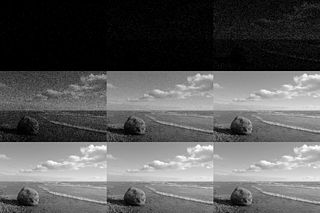
A photon noise simulation, using a sample image as a source and a per-pixel Poisson process to model an otherwise perfect camera. Courtesy Creative Commons.
Second, impaction increases geometrically in proportion to lens diameter and lens-mount or lens-barrel length ― a fact that LaFluts failed to mention, but that should be self-evident to anyone who followed his line of reasoning. The first century and a quarter of telescopy saw the production of increasingly longer observational instruments with ever-larger lenses. (Christiaan Huygens’s “interrupted telescope” without a tube, from 1691, was an ingenious effort at a solution to this problem.) Photographers worried about the impaction effect on their telephoto lenses might consider the plight of an astronomer like James Bradley of England, who, according to the late Isaac Asimov, in 1722 made use of a telescope 212 feet long.
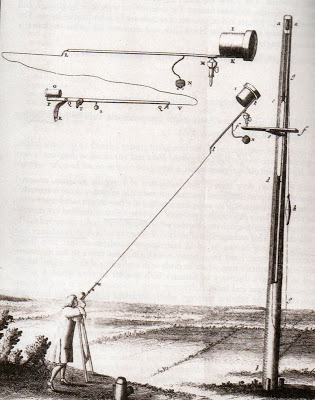
Christiaan Huygens’s “interrupted telescope” without a tube, 1691.
Bradley’s solution to the impaction problem — standard in his time — was what came to be known technically as dislodgement, or more colorfully as the “bloody great Whack”: a set of ringing blows struck simultaneously around the entire circumference of the instrument, between its glass elements, via a mechanism too elaborate to describe in this space. A bellows device was then used to force air rapidly through the length of the tube in order to “evacuate the Excesse,” according to the literature. (Was Arnold Eagle’s rubber mallet and blowing a small-scale, home-made version of this method?)
The photon had not yet been identified or named, of course; but the problem clearly had manifested itself. The crudeness of the solution may help to explain the erratic quality of telescopic observation during that period.
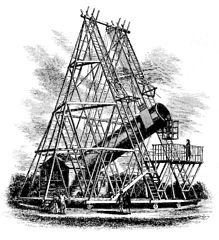
William Herschel’s 40-foot telescope, 1789.
More than half a century after Bradley, in 1789, the astronomer William Herschel ― immortalized for his discovery of Uranus, and father of John Herschel, himself a distinguised astronomer as well as a notable contributor to the invention of photography ― erected a telescope “large enough for him to crawl into” (according to Asimov, again; the source is his book, Eyes on the Universe). The initial purpose of this physical entry into the instrument was to enable Herschel to “search [for] the place of focus,” but thereafter it made it possible for his assistants to scrub the surface of the lens with a special detergent (whose complex formula, unfortunately, died with him). This was done on a monthly basis; according to Sir William’s notes, his prime motive was “to Expunge such Gremlyns of Light as may Distorte our Viewe … ”
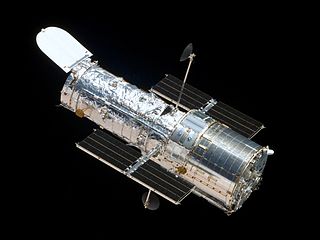
The Hubble Space Telescope as seen from the departing Space Shuttle Atlantis, May 19, 2009. Courtesy of NASA.
The incorporation of vacuum cleaners and photon-disposal units into the optical telescopes of our own time has virtually eliminated the problem for contemporary astronomers. (See the 2010 paper “Nanophotonic Ion Sources” by Jessica A. Stolee, Bennett N. Walker, Yong Chen, and Akos Vertes.) Radio telescopes, of course, are not subject to photonic impaction. Interestingly enough, however, they are afflicted by a parallel phenomenon, sound-wave adhesion.
For reasons not yet understood, stray bits of sound, bouncing around the ionosphere, sometimes get pulled into both outgoing and returning signals from these telescopes, and end up “residing” on the instruments’ receptors unless and until discharged by a brief, intermittent, rhythmic raising and lowering of the signal-to-noise ratio. Unfortunately, this is only a short-term solution; it lasts less than an hour. As of this writing, there’s no way of “adhesion-proofing” any instrument short of the method used with the internationally famous Hubble telescope: employ it only in the infinite vacuum tube of space.
Consequently, even the most knowledgeable astronomer, using the most sophisticated Earth-based radio telescope available, cannot be absolutely certain that he or she is registering the surface of Mars and not the murmurs of Björk. The flaws, limitations and biases of our observational instruments are the enduring “Gremlyns” of visual inquiry, whether that investigation is conducted with the naked eye or with our most innovative and elaborate extensions of sight.
•
(Drafted in April 1994, this essay appears here for the first time. My thanks to Ctein, who contributed some historical research to this post.)
•
This post supported by a donation from the Estate of Lyle Bongé.


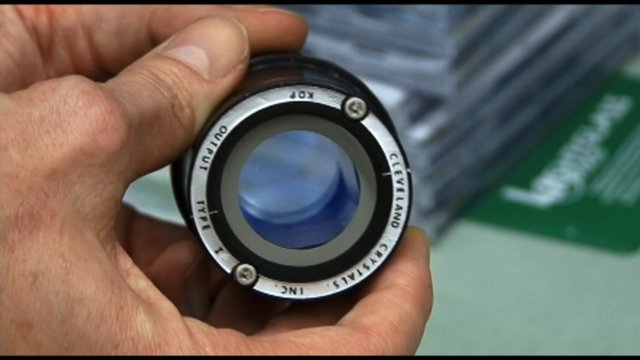
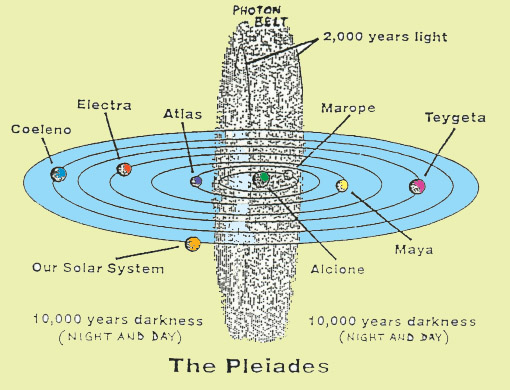




Consistently find your work fascinating A.D.
Thanks for keeping all this stuff flowing.
And how are you?
Best-
TA
I liked the “Beaugoss Digital Light Pump!”, beau gosse !
Great piece! ;o)
Brilliant! I wish I had seen this earlier so I could have brought it to my Photo I class this morning. I might be able to get a new generation of people to solemnly tap their lenses.
Happy _____ Day!
cheers
Bill
Hahahahahahaha…..